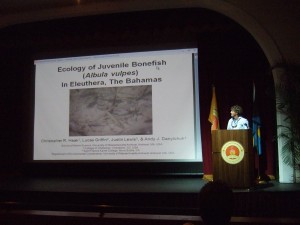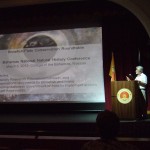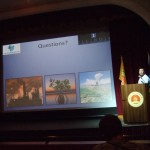Day 2 of the Bahamas National Natural History Conference had a session devoted to new research  on life history and management of a popular gamefish of the Bahamas, the bonefish (Albula vulpes). The bonefish session, moderated by Dr. Dave Philipp, Executive Director of the Fisheries Conservation Foundation (FCF), started off with a talk by UMass PhD student Chris Haak, who discussed his findings on the early life history of bonefish. With his findings, he theorized that juvenile bonefish actually mimic another species in the flats ecosystem, mottled mojarra, as a way to blend in with their schools for protection from predation.
on life history and management of a popular gamefish of the Bahamas, the bonefish (Albula vulpes). The bonefish session, moderated by Dr. Dave Philipp, Executive Director of the Fisheries Conservation Foundation (FCF), started off with a talk by UMass PhD student Chris Haak, who discussed his findings on the early life history of bonefish. With his findings, he theorized that juvenile bonefish actually mimic another species in the flats ecosystem, mottled mojarra, as a way to blend in with their schools for protection from predation.

 Next to speak was Dr. Karen Murchie from the College of the Bahamas, talking about movement patterns in bonefish and experiments with acoustic telemetry. She found that bonefish move regularly among tidal creeks in South Eleuthera, and was able to follow some fish for almost two years! Dave Philipp then discussed the reproductive ecology of bonefish, and some implications for conservation in the Bahamas. He emphasized the importance of determining source/sink populations to inform management. Dr. Aaron Adams, Director of Operations for the Bonefish Tarpon Trust, followed up with information on the tag and recapture of bonefish in relation to habitat conservation. Eleuthera now has the second highest number of tags put out in the Bahamas! Finally, Aaron Shultz, Director of CEI, discussed some of his PhD work looking at the blood chemistry response of mangrove fishes to acute climate change stressors across seasons. He found that checkered pufferfish and yellowfin mojarra, common residents of tidal creeks, have less of a physiological response to increased temperature and acidity than bonefish, who are more sensitive to hypothesized climate change conditions.
Next to speak was Dr. Karen Murchie from the College of the Bahamas, talking about movement patterns in bonefish and experiments with acoustic telemetry. She found that bonefish move regularly among tidal creeks in South Eleuthera, and was able to follow some fish for almost two years! Dave Philipp then discussed the reproductive ecology of bonefish, and some implications for conservation in the Bahamas. He emphasized the importance of determining source/sink populations to inform management. Dr. Aaron Adams, Director of Operations for the Bonefish Tarpon Trust, followed up with information on the tag and recapture of bonefish in relation to habitat conservation. Eleuthera now has the second highest number of tags put out in the Bahamas! Finally, Aaron Shultz, Director of CEI, discussed some of his PhD work looking at the blood chemistry response of mangrove fishes to acute climate change stressors across seasons. He found that checkered pufferfish and yellowfin mojarra, common residents of tidal creeks, have less of a physiological response to increased temperature and acidity than bonefish, who are more sensitive to hypothesized climate change conditions.
The bonefish session was followed by a roundtable discussion, also led by Dave Philipp, where bonefish research, policy, and outreach were discussed with a wide array of scientists, fishermen, and policy makers.